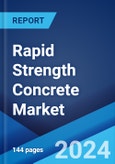The global rapid strength concrete market size reached USD 151.2 Billion in 2024. Looking forward, the market is expected to reach USD 223.0 Billion by 2033, exhibiting a growth rate (CAGR) of 4.19% during 2025-2033.
Rapid strength concrete (RSC) refers to a type of concrete that gains strength quickly and provides a lasting repair for the remaining service life of a structure. It is manufactured using high-quality ingredients and mixture designs and consequently offers numerous advantages over conventional concrete. As it helps businesses operating in the construction sector reduce their capital expenditure, RSC finds extensive applications in airports, dockyards, parking areas, and railway networks across the globe.
Consequently, it is utilized for repairing different components of buildings and substructure elements on bridges, such as decks, piers, and columns. Moreover, key players are focusing on minimizing the impact of producing concrete on the environment by developing next-generation sustainable cement. They are also engaging in collaborations and mergers and acquisitions (M&A) with domestic players, which is positively influencing the market. Furthermore, governing authorities of numerous countries are introducing new projects for constructing highways and freeways, which is facilitating the growth of the market.
Rapid strength concrete (RSC) refers to a type of concrete that gains strength quickly and provides a lasting repair for the remaining service life of a structure. It is manufactured using high-quality ingredients and mixture designs and consequently offers numerous advantages over conventional concrete. As it helps businesses operating in the construction sector reduce their capital expenditure, RSC finds extensive applications in airports, dockyards, parking areas, and railway networks across the globe.
Rapid Strength Concrete Market Trends:
The rising demand for modern architecture around the world represents one of the key factors bolstering the growth of the market. Besides this, there is a considerable increase in the use of RSC for pavement rehabilitation and reconstruction. These pavements provide a smooth and durable all-weather traveling surface to cars, trucks, buses, bicycles, commuters, commercial motor carriers, delivery and service providers, local users, and leisure travelers. In addition, they play a pivotal role in the roadway network of a country and offer societal benefits, such as access to schools, services, offices, and general mobility. Apart from this, as RSC reaches opening strength in a short period, slab replacement can be accomplished overnight.Consequently, it is utilized for repairing different components of buildings and substructure elements on bridges, such as decks, piers, and columns. Moreover, key players are focusing on minimizing the impact of producing concrete on the environment by developing next-generation sustainable cement. They are also engaging in collaborations and mergers and acquisitions (M&A) with domestic players, which is positively influencing the market. Furthermore, governing authorities of numerous countries are introducing new projects for constructing highways and freeways, which is facilitating the growth of the market.
Key Market Segmentation:
This report provides an analysis of the key trends in each sub-segment of the global rapid strength concrete market report, along with forecasts at the global, regional and country level from 2025-2033. Our report has categorized the market based on strength and application.Breakup by Strength:
- 0 To 40 MPa
- 40 To 80 MPa
- Above 80 MPa
Breakup by Application:
- Airport
- Building Floor
- Dockyard
- Formed Work
- Parking Areas
- Rail Network
- Roads and Bridges
- Others
Breakup by Region:
- North America
- United States
- Canada
- Asia-Pacific
- China
- Japan
- India
- South Korea
- Australia
- Indonesia
- Others
- Europe
- Germany
- France
- United Kingdom
- Italy
- Spain
- Russia
- Others
- Latin America
- Brazil
- Mexico
- Others
- Middle East and Africa
Competitive Landscape:
The competitive landscape of the industry has also been examined along with the profiles of the key players being Aggregate Industries (Holcim Group), Boral Limited, Bostik (Arkema S.A.), Buzzi Unicem SpA, Cemex S.A.B. de C.V., CTS Cement Manufacturing Corporation, Fosroc Inc. (JMH Group), Instarmac Group PLC, Short Load Concrete Inc., Sika AG, Tarmac (CRH plc) and Westbuild Group.Key Questions Answered in This Report:
- What was the size of the global rapid strength concrete market in 2024?
- What is the expected growth rate of the global rapid strength concrete market during 2025-2033?
- What are the key factors driving the global rapid strength concrete market?
- What has been the impact of COVID-19 on the global rapid strength concrete market?
- What is the breakup of the global rapid strength concrete market based on the application?
- What are the key regions in the global rapid strength concrete market?
- Who are the key players/companies in the global rapid strength concrete market?
Table of Contents
1 Preface3 Executive Summary10 Value Chain Analysis12 Price Analysis
2 Scope and Methodology
4 Introduction
5 Global Rapid Strength Concrete Market
6 Market Breakup by Strength
7 Market Breakup by Application
8 Market Breakup by Region
9 SWOT Analysis
11 Porters Five Forces Analysis
13 Competitive Landscape
List of Figures
List of Tables
Companies Mentioned
- Aggregate Industries (Holcim Group)
- Boral Limited
- Bostik (Arkema S.A.)
- Buzzi Unicem SpA
- Cemex S.A.B. de C.V.
- CTS Cement Manufacturing Corporation
- Fosroc Inc. (JMH Group)
- Instarmac Group PLC
- Short Load Concrete Inc.
- Sika AG
- Tarmac (CRH plc)
- Westbuild Group
Methodology

LOADING...
Table Information
| Report Attribute | Details |
|---|---|
| No. of Pages | 149 |
| Published | April 2025 |
| Forecast Period | 2024 - 2033 |
| Estimated Market Value ( USD | $ 151.2 Billion |
| Forecasted Market Value ( USD | $ 223 Billion |
| Compound Annual Growth Rate | 4.4% |
| Regions Covered | Global |
| No. of Companies Mentioned | 12 |









